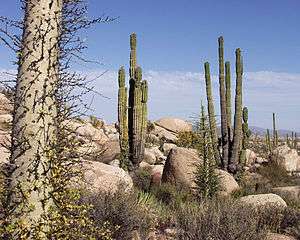Baja California Desert

The Baja California Desert is a desert ecoregion of Mexico's Baja California Peninsula.[1] This ecoregion occupies the western portion of the Baja California peninsula, and occupies most of the Mexican states of Baja California Sur and Baja California. It covers 77,700 square kilometers (30,000 square miles). The climate is dry, but the close proximity of the Pacific Ocean provides humidity and moderates the temperature. The flora mostly consists of xeric shrubs and over 500 species of vascular plants that have been recorded here.
Geography and climate
The ecoregion covers 77,700 square kilometers (30,000 square miles) and includes most of the Peninsula's western slope. It is bounded on the west by the Pacific Ocean and on the east by the Peninsular Ranges and is centered on the coordinates 27°44′N 113°36′W / 27.74°N 113.6°WCoordinates: 27°44′N 113°36′W / 27.74°N 113.6°W.[2] North of 30° north latitude, the Baja California desert transitions to the California chaparral and woodlands. The southern tip of the peninsula lies within the San Lucan xeric scrub ecoregion. To the north are the Sierra Juárez and San Pedro Mártir pine-oak forests, where a number of tree species are found including the near-threatened California Fan Palm.[3]
The climate is dry and subtropical. Although rainfall is low, the Pacific Ocean provides some humidity and moderates the temperature compared to the Sonoran desert, which lies on the east slope of the Peninsular Ranges.
The Baja California Desert ecoregion occurs on the western portion of the Baja California peninsula, and occupies most of the Mexican states of Baja California Sur and Baja California. Elevation is variable, ranging from mountain ranges on the western central part (1000 - 1500m), plains of median elevation (300 – 600m), and vast extensions of coastal dunes.
Flora
The ecoregion is mostly covered by xeric shrubs, which create varying associations based on elevation and soil conditions. The ecoregion has close to 500 species of vascular plants, of which a number are endemic, for example the Boojum tree or Creeping Devil.
References
- ↑ Taylor H. Ricketts, Eric Dinerstein, David M. Olson, Colby J. Loucks, et al. 1999
- ↑ World Wildlife Fund. "Baja California desert ecoregion". globalspecies.org. Retrieved March 7, 2012. External link in
|publisher=(help) - ↑ C. Michael Hogan. 2009
Notes
- C. Michael Hogan. 2009. California Fan Palm: Washingtonia filifera, GlobalTwitcher.com, ed. Nicklas Stromberg
- Taylor H. Ricketts, Eric Dinerstein, David M. Olson, Colby J. Loucks, et al. 1999. Terrestrial Ecoregions of North America: a Conservation Assessment. Island Press, Washington DC.
External links
- "Baja California desert". Terrestrial Ecoregions. World Wildlife Fund.